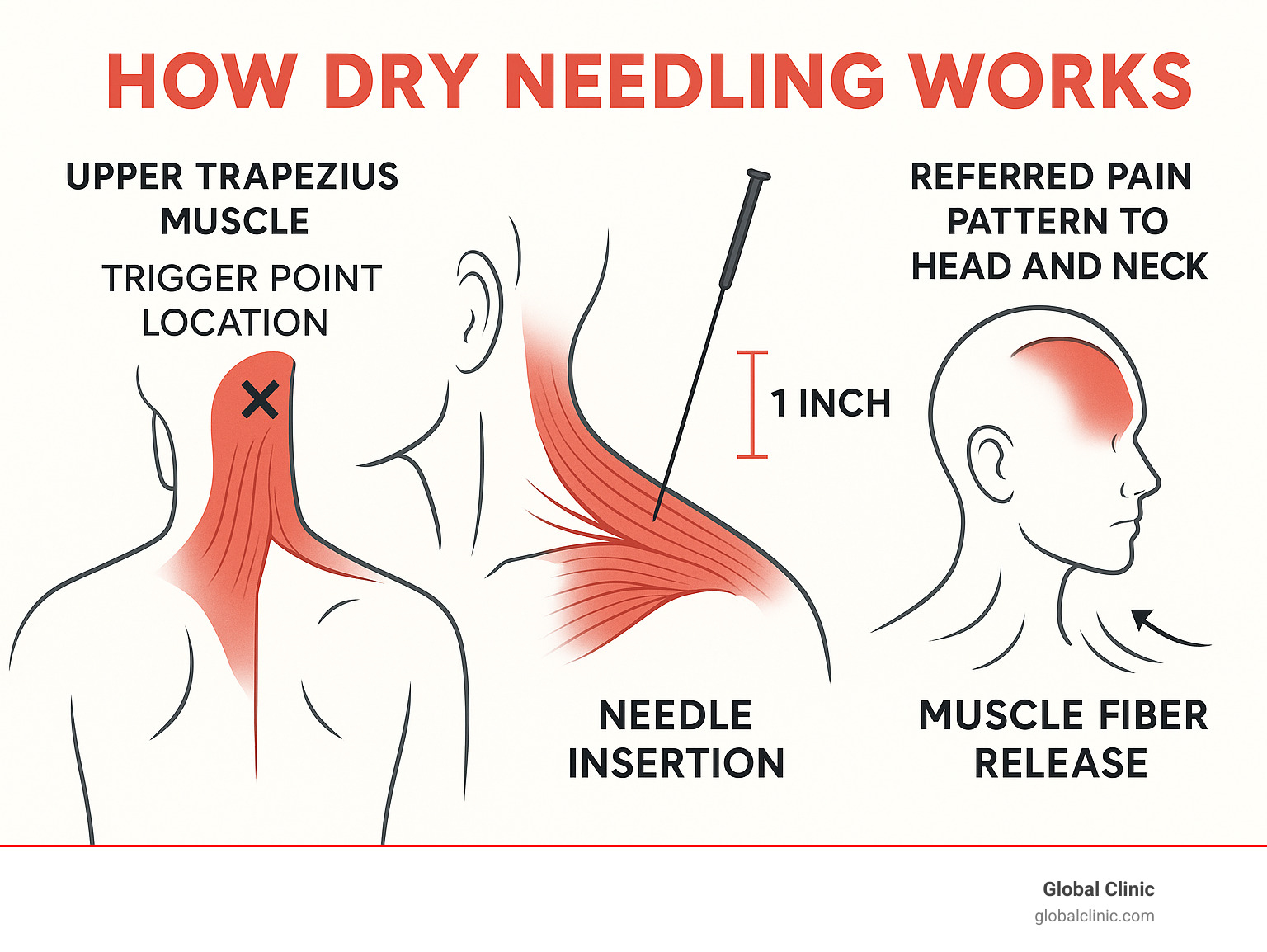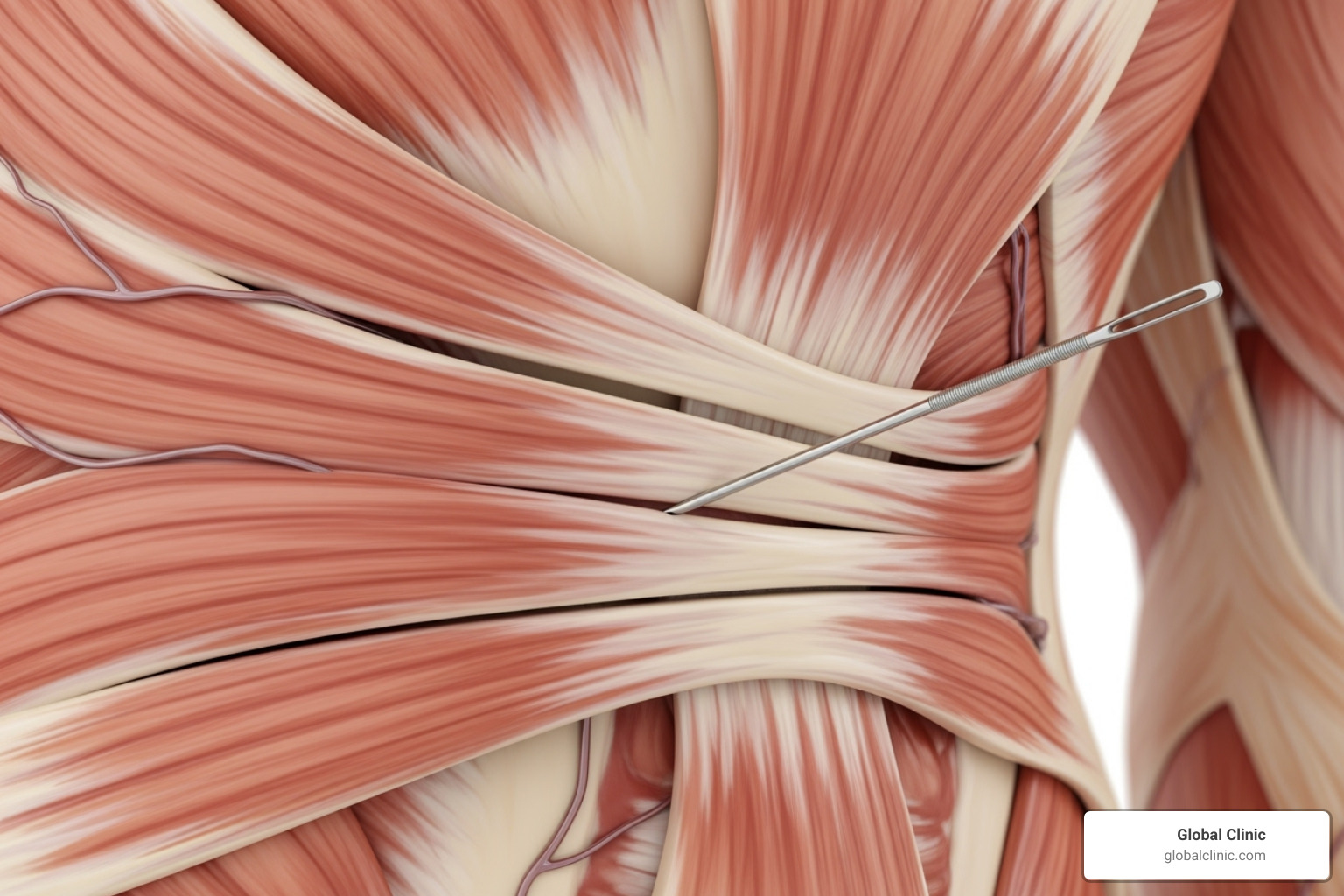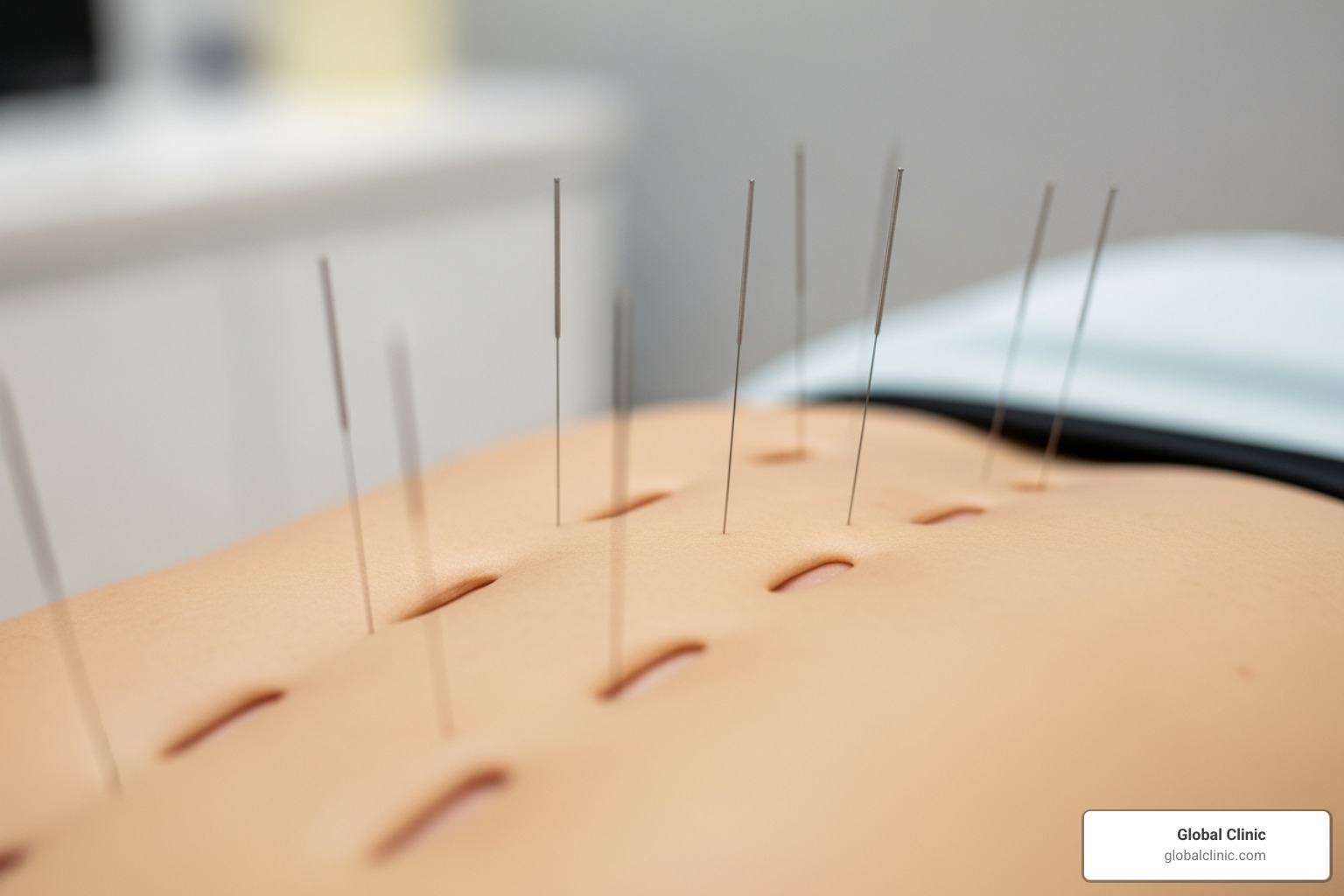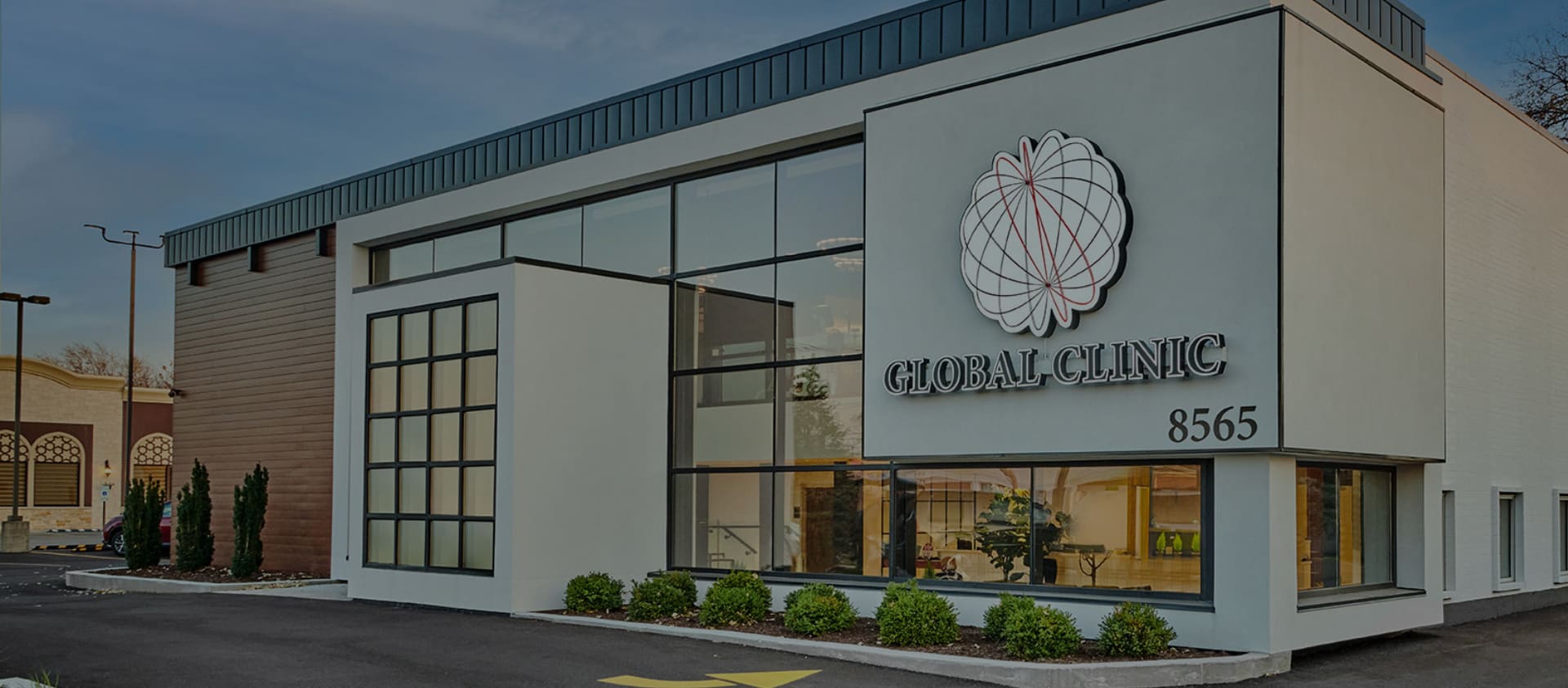Finding the Right Provider for Effective Pain Relief
When searching for dry needling near me, you want more than just proximity – you need a qualified provider who can deliver safe, effective treatment. Here’s what you need to know:
Quick Provider Checklist:
- Licensed physical therapist with specialized dry needling certification
- Postgraduate training in trigger point therapy (minimum 20+ hours)
- Clean, professional clinic environment
- Comprehensive evaluation process before treatment
- Integration with other physical therapy services
- Positive patient reviews and testimonials
What is Dry Needling?
Dry needling is a specialized technique where thin, sterile needles are inserted into myofascial trigger points (muscle knots) to relieve pain, reduce muscle tension, and improve movement. Unlike acupuncture, it’s based on modern Western medicine and targets specific anatomical structures.
The search for quality dry needling treatment can feel overwhelming when you’re dealing with chronic pain, tension headaches, or sports injuries. Many people start by typing “dry needling near me” into Google, but finding the right provider requires looking beyond just location. The difference between an average session and transformative treatment often comes down to the practitioner’s training, approach, and how they integrate dry needling into your overall care plan.
As Ana Vinikov, Practice Manager at Global Clinic with over 20 years of experience in pain management, I’ve seen how proper dry needling near me searches can connect patients with life-changing treatment when they know what to look for. Our multidisciplinary approach has helped countless patients in Northern Chicago find lasting relief through evidence-based dry needling protocols.

Essential dry needling near me terms:
What is Dry Needling and How Does It Work?
Ever wondered how those tiny needles can make a big difference in muscle pain? Dry needling is a modern and incredibly effective physical therapy technique. It uses very thin, solid needles – much like the ones you might see in acupuncture – but its purpose is quite different. Instead of targeting energy pathways, we use them to find and release those stubborn spots in your muscles called myofascial trigger points. Think of these as super tight “muscle knots” that can cause pain right where they are, or even send aches to other parts of your body.

The “dry” part of dry needling simply means there’s no medication involved – just the needle itself. When our trained physical therapists carefully insert a needle into one of these trigger points, you might feel a quick, brief muscle jump. We call this a “local twitch response.” It’s actually a good sign! This twitch tells us we’ve hit the right spot, and it’s the first step in helping your muscle relax and break the pain cycle.
By gently stimulating these points, dry needling helps your muscles let go of tension, boosts blood flow to the area, and even helps “reset” how your brain and muscles communicate. The aim? To reduce your pain, improve your range of motion, and help your muscles work properly again. Many of our patients at Global Clinic feel relief quite quickly, with even better improvements in how their muscles move over time.
The Science Behind the Needle
So, how exactly does a tiny needle lead to such big relief? It’s all about how your body responds. When a needle goes into a trigger point, it creates a very small, harmless “micro-injury.” This tiny action kicks your body’s natural healing processes into high gear.
First, it helps to break the pain cycle. By deactivating those cranky trigger points, dry needling essentially tells your brain to stop sending pain signals from that area, giving your muscle a chance to reset. Second, that micro-stimulation increases blood flow. More blood means more oxygen and nutrients rushing to the muscle, which are essential for healing and for sweeping away waste products that build up in tight muscles.
Third, the local twitch response and the needle’s presence help to release muscle tension. Those tight, shortened muscle bands start to relax and lengthen, bringing back flexibility and easing stiffness. Finally, dry needling can create a powerful neurological reset. It positively influences your nervous system, helping to calm muscle spasms, improve how your muscles “fire,” and reduce overall sensitivity to pain. This comprehensive approach is why dry needling is such a powerful tool for lasting pain relief and better movement.
How is Dry Needling Different from Other Techniques?
While dry needling is a fantastic tool for managing pain, it’s often most effective when used as part of a larger treatment plan. At Global Clinic, we frequently combine it with other physical therapy techniques to give you the most comprehensive care. Here’s a quick look at how it stands out from some common approaches:
| Feature | Dry Needling | Manual Therapy (e.g., massage, mobilization) | Therapeutic Exercise (e.g., stretching, strengthening) |
|---|---|---|---|
| Approach | Invasive; direct insertion of thin needles into muscle tissue. | Hands-on techniques applied by the therapist; external manipulation. | Active patient participation through prescribed movements and activities. |
| Target | Myofascial trigger points, muscle fibers, connective tissues, nervous system. | Soft tissues, joints, fascia, and muscles to improve mobility and reduce pain. | Specific muscles or muscle groups to improve strength, flexibility, endurance, and coordination. |
| Conditions Treated | Muscle pain, spasms, tension headaches, sciatica, sports injuries, chronic pain (often related to trigger points). | Joint stiffness, muscle tightness, reduced range of motion, pain from musculoskeletal imbalances. | Weakness, imbalance, post-injury recovery, limited range of motion, chronic pain requiring stabilization. |
| Practitioner Training | Specialized postgraduate training and certification required for safe and effective practice. | Integral part of physical therapy education; advanced certifications available for specific techniques. | Core component of all physical therapy programs; ongoing education for specialized populations. |
What makes dry needling a truly unique and specialized physical therapy intervention is its ability to directly address the internal source of muscle dysfunction, like those pesky trigger points, in a way that external methods often can’t fully achieve. It beautifully complements other therapies by getting the muscle ready for stretching, strengthening, and overall improved movement. This makes it a key part of our personalized, innovative care approach here at Global Clinic.
Benefits, Conditions, and What to Expect from Treatment
Imagine waking up feeling less stiffness, moving with more ease, and getting back to the activities you love. That’s the kind of freedom many of our patients find with dry needling. At Global Clinic, we’ve seen how this innovative therapy can truly transform lives. It’s not just about pain relief; it’s about giving you back your active life.

One of the biggest wins is often pain relief. By gently targeting those pesky muscle knots, dry needling helps quiet the pain signals, offering a real sense of calm to your muscles. This relief naturally leads to improved mobility and range of motion. When your muscles aren’t constantly fighting themselves, they can move freely, letting you reach higher, bend lower, and simply move better. For athletes or anyone recovering from an injury, dry needling can even lead to faster recovery by boosting your body’s natural healing processes. And those frustrating, involuntary muscle twitches? Dry needling helps achieve reduced muscle spasms, bringing much-needed calm to irritated muscles. Finally, with less tension and improved muscle function, you’ll often notice a wonderful increase in your overall flexibility, making everyday movements feel smoother and more comfortable.
Common Conditions Treated with Dry Needling
So, who can benefit from dry needling? The truth is, it’s incredibly versatile! We’ve seen it work wonders for a wide range of conditions, helping people find relief from everything from nagging chronic issues to acute sports injuries.
If you’re dealing with persistent aches, dry needling can be a game-changer for chronic back pain, which often stems from tight muscles and poor posture. You can learn more about Addressing Back Pain with Physical Therapy. We also frequently treat neck pain and the lingering discomfort of whiplash, helping to release that deep-seated tension. Those relentless tension headaches and even some migraines often find relief when we address trigger points in the neck and shoulders.
For nerve-related discomfort, dry needling can be highly effective for conditions like sciatica and piriformis syndrome, by loosening the tight gluteal muscles that can press on nerves. We have more insights on that topic in our article comparing Piriformis Syndrome vs. Sciatica.
Are you an athlete or just someone who enjoys staying active? Dry needling is fantastic for sports injuries, speeding up recovery from muscle strains, sprains, and common overuse issues like Achilles tendinitis, shin splints, or IT band syndrome. Even specific nerve compression issues like carpal tunnel syndrome can see improvement as we address muscle tightness in the forearm and wrist. And if your feet are giving you trouble, particularly with heel pain, we often use dry needling for plantar fasciitis, targeting those calf and foot muscles. You can also explore our guide on How to Relieve Knee Pain for related insights.
Beyond these, dry needling can help with generalized joint pain in areas like the hips, knees, or elbows by easing tension in surrounding muscles. It’s also used for TMJ disorders to alleviate jaw and facial pain, and even to help manage the widespread muscle pain often associated with fibromyalgia.
Your First Dry Needling Session: A Step-by-Step Guide
Curious about your first dry needling session? It’s completely normal to have questions! At Global Clinic, we want you to feel comfortable and informed every step of the way. When you come in for your initial visit, here’s what you can generally expect:
First, we’ll start with a thorough initial evaluation. Think of it as our chance to get to know you and your body better! Your certified physical therapist will chat with you about your medical history, listen carefully to your symptoms, and perform a detailed physical examination. This helps us pinpoint exactly what’s going on and decide if dry needling is the best path for your unique situation and to identify those precise trigger points.
Next, we’ll help you get into the most comfortable patient positioning, usually lying down, with just the treatment area exposed. Our therapists will gently cleanse the skin over the target area – hygiene is always a top priority!
Now for the needle! It’s natural to wonder about the needle insertion sensation. The needles we use are incredibly fine, often thinner than a strand of hair. Many people describe feeling just a tiny prick or a light tap as the needle enters the skin. The more unique sensation comes as the needle reaches that tight trigger point. You might feel what we call a “good ache,” a mild cramp, or a quick, involuntary twitch response from the muscle. This little “twitch” is actually a good sign! It tells us we’ve hit the target and the muscle is reacting, ready to release that tension. This sensation is usually very brief.
The treatment duration is typically quite short. The needles might stay in place for just a few seconds, or up to about 15 minutes, depending on the specific muscle and your body’s needs. Sometimes, your therapist might gently adjust the needle to ensure optimal release – it’s all about getting that muscle to relax!
After your session, it’s pretty common to experience some post-treatment soreness. It might feel a bit like you’ve had a good, deep workout, lasting for about 24 to 48 hours. This is a normal part of your body’s healing process as it adjusts to the released tension. Don’t worry, we won’t leave you hanging! We’ll give you clear, easy-to-follow recommendations for managing any discomfort, like applying ice or heat, doing some gentle stretches, or simply staying well-hydrated.
Finally, we want to assure you about our safety protocols. Your well-being is our top concern. We use only sterile, single-use needles that are immediately and safely disposed of after each treatment. Our practitioners are not just skilled; they are rigorously trained and certified in dry needling techniques, adhering to the highest standards to ensure your safety and comfort throughout your entire journey with us. When you’re searching for dry needling near me, know that Global Clinic prioritizes your safety above all else.
Finding Qualified Dry Needling Near Me
When you’re searching for dry needling near me, finding the right practitioner can feel overwhelming—especially when you’re already dealing with pain. The good news? You don’t have to settle for just anyone with needles. The quality of your treatment depends heavily on your provider’s training, credentials, and approach to care.
At Global Clinic, we’ve seen too many patients who tried dry needling elsewhere without getting the results they hoped for. Often, the difference comes down to proper training and taking a comprehensive approach to your care. Our team understands that dry needling near me searches should lead you to practitioners who view this technique as one powerful tool in a larger toolkit—not a quick fix performed in isolation.
State licensing boards have different requirements for dry needling, which means the practitioner you choose matters more than you might think. The right provider will always start with a thorough assessment, use sterile needles and proper safety protocols, and integrate dry needling into a comprehensive treatment plan custom to your specific needs.
Who Is Qualified to Perform Dry Needling Near Me?
Physical therapists are typically your best bet when searching for dry needling near me. Their background in musculoskeletal anatomy, biomechanics, and movement science provides the perfect foundation for this specialized technique. Unlike practitioners from other fields, physical therapists understand how muscles, joints, and movement patterns work together—knowledge that’s crucial for effective trigger point therapy.
The key is finding a physical therapist with specialized postgraduate training in dry needling. This isn’t something you learn in a weekend workshop. Quality programs require a minimum of 20 hours of intensive, hands-on coursework that covers everything from needle insertion techniques to managing patient responses and potential complications.
Look for certifications from reputable organizations that follow evidence-based practice guidelines established by the American Physical Therapy Association. These certifications demonstrate that your practitioner has met rigorous educational and practical standards—not just attended a basic seminar.
While dry needling uses similar needles to acupuncture, the approaches are completely different. Dry needling is rooted in modern Western medicine and focuses specifically on myofascial trigger points and muscle dysfunction. You want a practitioner trained in this scientific approach, not someone trying to blend different philosophies.
How to Choose the Best Practitioner for Dry Needling Near Me
Choosing the right provider involves looking beyond location and price. Start by checking credentials and experience—verify their physical therapy license and ask specifically about their dry needling certification and training. Don’t be shy about asking how many patients they’ve treated with this technique. Experience matters when you’re dealing with precise needle placement and managing different patient responses.
Reading patient reviews can give you valuable insights, but look for specific details about the dry needling experience rather than just general satisfaction scores. Pay attention to comments about pain relief, the practitioner’s communication style, and whether patients felt comfortable during treatment.
Ask about their treatment approach during your initial consultation. Red flags include practitioners who only offer dry needling without other therapies, or those who promise unrealistic results. The best providers integrate dry needling into comprehensive care plans that address your specific condition from multiple angles.
A quality practitioner will insist on a thorough initial assessment before any needles come out. This evaluation should include your medical history, physical examination, and discussion of your goals and concerns. Anyone willing to start sticking needles in you without this assessment isn’t following proper protocols.
Finally, trust your gut about their communication style. You should feel comfortable asking questions and confident that they’re explaining everything clearly. At Global Clinic, we believe informed patients get better results, which is why we take time to ensure you understand every aspect of your treatment plan. This holistic approach often complements other services—you can learn more about our comprehensive care philosophy in our article on How Physical Therapy Can Transform Your Life.
Frequently Asked Questions about Dry Needling
We understand you might have more questions about dry needling. It’s totally normal to be curious about a new treatment! Here are answers to some of the most common inquiries we receive:
Is dry needling painful?
Many people wonder if dry needling hurts. It’s a great question! Most of our patients describe the sensation as more of a discomfort or a unique feeling rather than outright pain. Think of it like a quick, tiny prick as the needle goes in.
When the needle reaches that “muscle knot” – what we call a trigger point – you might feel a deep ache, a mild cramp, or even a quick muscle twitch. This “twitch” is actually a good sign! It means the muscle is reacting and starting to release its tension. While this can feel intense for a moment, it usually passes very quickly.
Afterward, it’s totally normal to feel a bit sore, like you’ve had a good workout. This post-session soreness typically lasts a day or two, and we’ll give you tips on how to make yourself comfortable, whether with ice or heat.
How many sessions will I need?
This is a common question, and the honest answer is: it really depends on you and your specific condition! There’s no one-size-fits-all number when it comes to dry needling sessions.
For instance, if you have a newer, acute injury, you might feel much better after just a few sessions. But for chronic, long-standing pain, it could take a bit more time and a series of treatments to achieve lasting relief. Your body’s unique response also plays a role – some people feel significant improvement very quickly, while others need a bit more gradual support.
Dry needling is often part of a bigger, comprehensive plan, combined with exercises, stretching, and other therapies to help you reach your goals. Your physical therapist at Global Clinic will always keep you in the loop, constantly checking your progress and adjusting your plan so you get the best results.
Is dry needling safe and are there side effects?
Safety is always our top priority, and you can rest assured that dry needling is very safe when performed by a qualified professional. At Global Clinic, we take every precaution.
Our physical therapists are highly trained – they’ve gone through specialized postgraduate training specifically for dry needling. This means they truly understand your body’s anatomy and how to perform the technique safely and effectively. We also use only sterile, single-use needles, which are disposed of immediately after your session. This eliminates any risk of infection.
As for side effects, they are usually mild and temporary:
- The most common one is that familiar post-treatment soreness, like after a workout, which fades within a day or two.
- You might also notice a tiny bruise or a pinprick of blood at the needle site, especially in areas where blood vessels are closer to the surface.
- Some people even report feeling a bit tired after a session, as their body processes the treatment.
Serious side effects are incredibly rare, especially when you choose a certified practitioner for your dry needling near me search. We’ll always have an open conversation with you during your initial visit about any potential risks or if dry needling isn’t the best fit for your specific health situation.
Conclusion: Taking the Next Step Toward Pain Relief
You’ve journeyed through dry needling, finding how this powerful, evidence-based therapy can be a game-changer for muscle pain, tension, and limited movement. From offering targeted pain relief and boosting your mobility to speeding up recovery from nagging injuries, dry needling is truly a valuable tool in modern physical therapy.
The secret to open uping all these amazing benefits? It’s all about choosing the right expert. When you’re searching for dry needling near me, it’s crucial to look beyond just location. Prioritize expertise, a commitment to safety, and a physical therapist who believes in a comprehensive approach to your care. Here at Global Clinic, we are deeply committed to providing personalized, innovative care right in our state-of-the-art facility in Northern Chicago. Our certified therapists expertly weave dry needling into holistic treatment plans, all designed to help you find lasting pain relief and truly reclaim your quality of life. We’re here to empower you with effective solutions that go far beyond just quick fixes.
Ready to experience the transformative potential of dry needling for yourself? Don’t let pain hold you back any longer. We invite you to contact us today to schedule your consultation and take that vital next step toward a pain-free future. You can also Explore our specialized Pelvic Floor Physical Therapy services to see another way we’re dedicated to your well-being.



